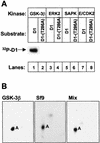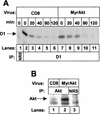Glycogen synthase kinase-3beta regulates cyclin D1 proteolysis and subcellular localization
- PMID: 9832503
- PMCID: PMC317244
- DOI: 10.1101/gad.12.22.3499
Glycogen synthase kinase-3beta regulates cyclin D1 proteolysis and subcellular localization
Abstract
The activities of cyclin D-dependent kinases serve to integrate extracellular signaling during G1 phase with the cell-cycle engine that regulates DNA replication and mitosis. Induction of D-type cyclins and their assembly into holoenzyme complexes depend on mitogen stimulation. Conversely, the fact that D-type cyclins are labile proteins guarantees that the subunit pool shrinks rapidly when cells are deprived of mitogens. Phosphorylation of cyclin D1 on a single threonine residue near the carboxyl terminus (Thr-286) positively regulates proteasomal degradation of D1. Now, we demonstrate that glycogen synthase kinase-3beta (GSK-3beta) phosphorylates cyclin D1 specifically on Thr-286, thereby triggering rapid cyclin D1 turnover. Because the activity of GSK-3beta can be inhibited by signaling through a pathway that sequentially involves Ras, phosphatidylinositol-3-OH kinase (PI3K), and protein kinase B (Akt), the turnover of cyclin D1, like its assembly, is also Ras dependent and, hence, mitogen regulated. In contrast, Ras mutants defective in PI3K signaling, or constitutively active mitogen-activated protein kinase-kinase (MEK1) mutants that act downstream of Ras to activate extracellular signal-regulated protein kinases (ERKs), cannot stabilize cyclin D1. In direct contrast to cyclin D1, which accumulates in the nucleus during G1 phase and exits into the cytoplasm during S phase, GSK-3beta is predominantly cytoplasmic during G1 phase, but a significant fraction enters the nucleus during S phase. A highly stable D1 mutant in which an alanine is substituted for the threonine at position 286 and that is refractory to phosphorylation by GSK-3beta remained in the nucleus throughout the cell cycle. Overexpression of an active, but not a kinase-defective, form of GSK-3beta in mouse fibroblasts caused a redistribution of cyclin D1 from the cell nucleus to the cytoplasm. Therefore, phosphorylation and proteolytic turnover of cyclin D1 and its subcellular localization during the cell division cycle are linked through the action of GSK-3beta.
Figures







References
-
- Albanese C, Johnson J, Watanabe G, Eklund N, Vu D, Arnold A, Pestell RG. Transforming p21ras mutants and c-Ets-2 activate the cyclin D1 promoter through distinguishable regions. J Biol Chem. 1995;270:23589–23597. - PubMed
-
- Baldin V, Lukas J, Marcote MJ, Pagano M, Draetta G. Cyclin D1 is a nuclear protein required for cell cycle progression in G1. Genes & Dev. 1993;7:812–821. - PubMed
-
- Beals CR, Sheridan CM, Turck CW, Gardner P, Crabtree GR. Nuclear export of NF-ATc enhanced by glycogen synthase kinase-3. Science. 1997;275:1030–1033. - PubMed
-
- Boudewijn M, Burgering T, Coffer PJ. Protein kinase B (c-Akt) in phosphatidylinositol-3-OH kinase signal transduction. Nature. 1995;376:599–602. - PubMed
Publication types
MeSH terms
Substances
Grants and funding
LinkOut - more resources
Full Text Sources
Other Literature Sources
Medical
Molecular Biology Databases
Research Materials
Miscellaneous
